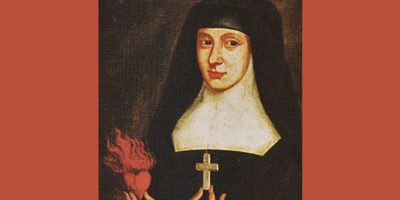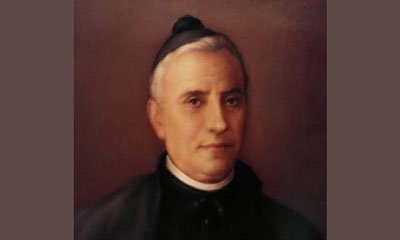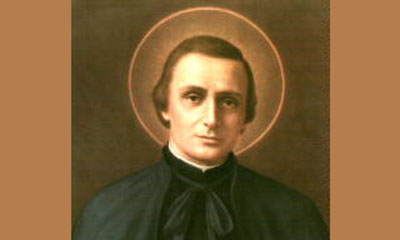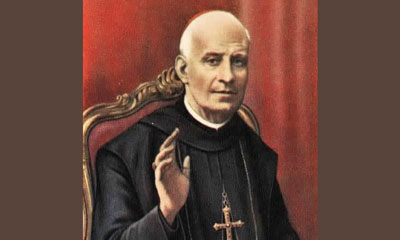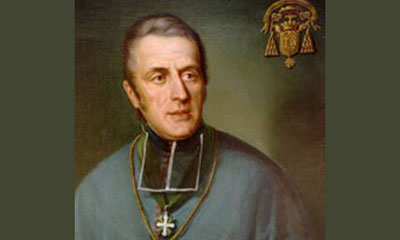July 25, 2017
Venerable Anne-Madeleine Rémuzat
Dear Friends,
“Madeleine, behave yourself! Don’t run like that!” This was a mother’s repeated call, on the way out of the Church of Accoules in Marseilles, at the beginning of the eighteenth century. The energetic little girl, who had stayed still throughout Mass, returned, out of breath. Certainly the mother generally managed to keep her child reasonably quiet, but she often wondered how to calm this little Madeleine who was so lively and impetuous, who didn’t listen to anyone or focus on anything, and who was continuously coming and going. It finally would be a burning love for Jesus that would root her firmly in Him, making her an ardent apostle of devotion to His Sacred Heart.
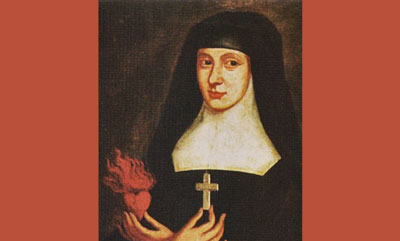 Madeleine’s father, Hyacinthe Rémuzat, belonged to Marseilles’ upper class. He was in the maritime trade. His wife Anne, née Coustan, was also from a prominent family in Provence, formed by sentiments of honor and integrity, whose primary claim to nobility was its profoundly Christian character. The seventh of twelve children, Madeline was baptized on November 29, 1696, the same day she was born. As soon as she began to speak, she was taught to say the names of Jesus and Mary. The mother adapted her methods to each child’s personality, punishing when needed, not inflexibly but not weakly. Madeleine, however, was a challenge. Her family loved her very much, but the little girl avoided all displays of affection; moreover, she automatically would try to do whatever was forbidden. Only her mother was able to speak to her heart, and when she told her “no,” the girl did not insist. Over the years, her family observed an unexpected change in Madeleine’s behavior. She increasingly kept a watch on herself, avoiding misbehavior. “I want to become a nun!” she explained one day. Her brothers and sisters retorted, “You? So lively and temperamental? But to make her happy, her parents promised to entrust her to the Visitation Sisters to complete her upbringing.
Madeleine’s father, Hyacinthe Rémuzat, belonged to Marseilles’ upper class. He was in the maritime trade. His wife Anne, née Coustan, was also from a prominent family in Provence, formed by sentiments of honor and integrity, whose primary claim to nobility was its profoundly Christian character. The seventh of twelve children, Madeline was baptized on November 29, 1696, the same day she was born. As soon as she began to speak, she was taught to say the names of Jesus and Mary. The mother adapted her methods to each child’s personality, punishing when needed, not inflexibly but not weakly. Madeleine, however, was a challenge. Her family loved her very much, but the little girl avoided all displays of affection; moreover, she automatically would try to do whatever was forbidden. Only her mother was able to speak to her heart, and when she told her “no,” the girl did not insist. Over the years, her family observed an unexpected change in Madeleine’s behavior. She increasingly kept a watch on herself, avoiding misbehavior. “I want to become a nun!” she explained one day. Her brothers and sisters retorted, “You? So lively and temperamental? But to make her happy, her parents promised to entrust her to the Visitation Sisters to complete her upbringing.
Fall, cry, and pick oneself up again
Around the age of nine, Madeleine entered the Visitation of the “Petites-Maries” as a boarder. She joyfully took the little habit that was reserved for boarders, and confidently insisted that God was calling her to religious life. But soon, in spite of her goodwill and attraction to this life she had chosen, her restless nature resurfaced. She even fell into a fault that she would relate later to the novices who would be entrusted to her: “Have you put away your embroidery things?” a sister asked the students one day. “Yes, my sister!” “And you, Madeleine?” The answer given in an uncertain voice did not convince the nun. “You haven’t taken something that wasn’t yours? What do you have in your apron?” “Nothing!” “What do you mean nothing? And this? Are these balls of silk? Repent of your sin and confess to it without lying! It’s not good to lie, you know.” The bell rang, and Madeleine made her way to the refectory. On the way, she became aware of the wickedness of her attitude, and went to the church to give free rein to her tears. There, Jesus appeared to her burdened by His Cross and, enveloping her in a look of sadness and merciful kindness, He told her: “It is you, my daughter, who put Me in this state!” Peace then returned to her soul. She went to ask the teacher’s forgiveness for her theft and her lie, promising not to do it again. This weakness became for her the occasion for a new start. From this time on, she meditated on the Passion of Jesus. To prove her love for Him, she made an effort to overcome her aversions, such as approaching one of her classmates she had previously neglected, overcoming her fear of insects, or of the dark, by going out one evening to put out a candle in a classroom she was responsible for.
As her first Communion drew near, she was often seen in tears. During the preparatory retreat, a nun questioned her about it. “I will soon have the happiness of receiving my God,” Madeleine answered. “I cannot think about it without shedding a flood of tears.” Often feeling a mysterious interior suffering, she questioned the Lord in prayer. In July 2, 1708, which at that time was the feast of the Visitation of Our Lady, Madeleine distinctly heard an interior voice after Communion: “I want you to be faithful to Me!” The face of Jesus appeared for a long time, gazing at her. The Lord said to her: “I am looking for a victim.” To dispel this vision, she closed her eyes, but Jesus was still there! He concluded: “It is you, My daughter, I choose to be My victim!” Indeed, Jesus chooses certain people and asks them to share with Him, as victims, the sufferings through which He performed the Redemption, providing whatever graces are necessary. He Himself was indeed a victim, as Saint John declares: In this is love, not that we loved God but that He loved us and sent His Son to be the expiation for our sins (1 Jn. 4:10).
“It is indeed Jesus!”
The Lord’s visits to Madeleine became increasingly frequent. But, towards the end of 1708, she went through a period of spiritual dryness: all feeling was taken away from her in prayer. The devil then suggested to her that the union with Christ she had experienced was nothing but an illusion, the fruit of her vanity. None of it had come from God! Disturbed, Madeleine confided in her instructress, who after having listened, showed her that these doubts came from the evil one. She had to reject them as soon as they appeared. “Believe me,” she told her, “it is indeed Jesus Who is speaking to you, it is indeed He Who has called you.” Madeleine then asked to be able to regularly go to a Jesuit priest who had been recommended to her. When this request was refused by the superior, she decided, in January 1709, to return home to her parents. The bishop himself, Bishop de Belsunce, saw to her spiritual direction by referring her to Father Milley, a Jesuit. She established a program of life that included holy Mass, times of prayer, but also visits to the sick and help to the neediest. Two years went by. Beautiful and talented, the young woman received and, over her parents’ objection, refused several offers of marriage. Fifteen years old, and determined to enter the Visitation convent of the Grandes Maries, she requested and obtained the bishop’s approval. The morning of October 2, 1711, without telling anyone, she entered the convent. Her parents, furious, came to take her home. But the postulant pleaded her case so calmly that they ended up giving their consent, not without sadness.
Right away the new recruit edified the nuns, not only by her observance and her virtues, but also by her compassion. When she received the monastic veil, the name “Anne” was added to her first name, the name of her mother and one of her sisters. Soon, she was assigned to assist in the novitiate. However, as her health was showing signs of weakening, the Mother Superior barred her from fasting and abstinence. “And here we have someone who has good things to eat,” exclaimed a novice, “while the others are observing Lent!” Sister Anne-Madeleine did not answer. “Why didn’t you say anything?” an older nun asked her. “Because I know that one is always right to criticize me, and that I can do nothing better than be silent, continuing to obey.” Sister Anne-Madeleine was given the task of receiving those who asked to meet with a nun for spiritual advice. She listened to them tirelessly and directed them to the sacrament of Penance. In January 1713, she made her profession. Bishop de Belsunce gave her the new veil: “This will be a veil over your eyes against all the gazes of man, and a sacred sign that you will never receive any sign of love except from Jesus Christ.”
Profound disturbance
At this time, the Jansenist error was widespread in France, disturbing the life of the Church and society. According to this doctrine, Christ did not shed His Blood for all men, but only for a small fraction of them. As for the others, access to the fruits of the Redemption would be closed to them forever, no matter what they did. On the other hand, to receive Eucharistic Communion, the Jansenists demanded not only that one be in a state of grace (cf. Catechism of the Catholic Church, no. 1415), but also have a disposition of pure love of God, without any faults. This severity kept the faithful away from Holy Communion. On September 8, 1713, Pope Clement XI condemned the Jansenist errors in the Bull Unigenitus Dei Filius. In France, this text was met with great resistance. The political and religious situation became extremely tense.
Today, we often hear opposing errors professed. The truth taught by the Church, that Christ offered His life for all men without exception, is certainly correct, but it would be an opposing error to conclude from this that everyone enters the Kingdom, however they live their life. For as Saint Augustine stated (quoted by the CCC, no. 1847), “God created us without us: but He did not will to save us without us.” Faith and good works are necessary for eternal salvation. Faith because Our Lord affirms the need to believe in His Word to be saved: He who believes and is baptized will be saved; but he who does not believe will be condemned (Mk. 16:16); works because, to the rich man who posed the question: what good deed must I do, to have eternal life?, Jesus answered: If you would enter life, keep the commandments (Mt. 19:16-17). Moreover, Not everyone who says to Me, ‘Lord, Lord,’ shall enter the kingdom of heaven, but he who does the will of my Father Who is in heaven (Mt. 7:21).
But as the ministry of listening to and advising others increasingly weighed on her, Sister Anne-Madeleine obtained permission to be dismissed from it. She then devoted more time to Jesus in the adoration of the Blessed Sacrament, to console His Heart. In spite of external appearances, she suffered greatly in her soul. “As severe as God appears to me,” she confided to her superior, “I will not cease to depend on Him. It is enough for me to know that He is infinitely lovable, for me to make every effort to love Him. It is Him I seek, and not His rewards… I suffer willingly, because He wishes it, and I gladly sacrifice, because He wishes it, and I am pleased to sacrifice my satisfaction to the fulfillment of His will.”
In his battle against Jansenism, Bishop de Belsunce encountered the opposition of some priests and also of the parliament of Aix-en-Provence. Aware of the gifts that Sister Anne-Madeleine had received from God, the superior asked her to resume her ministry to those who came to her for direction. Confronted with the pride that pushed the Jansenists to raise themselves against the Church and the Pope, the humble sister taught that everyone should remain in his place as a creature in the hands of God: “Let us be what we are, and be it well, to give honor to the Master Worker whose work we are… Let us be what God wants, provided that we are His, and let us not be what we want, contrary to His intent.” Moved by the difficult times for the Church, she added prayer and sacrifices to her words. Thanks to her, many people went from tepidness and indifference toward others to a life in accordance with the Gospel and the teaching of the Church.
This Heart which has loved so greatly
In 1716, during her annual retreat, Sister Anne-Madeleine received an extraordinary mystical grace from the Lord that united her more intimately with the Holy Trinity. Some forty years earlier, Jesus had revealed to another Visitandine, Saint Margaret Mary Alacoque, how greatly He desired that His Sacred Heart, Which had so greatly loved mankind, be honored. This devotion, spurned by the Jansenists, was spread in many Visitation convents, including those in Marseilles. Jesus was now inspiring Sister Anne-Madeleine to continue the work begun in Paray-le-Monial by founding an association dedicated to His Sacred Heart, with the goal of “first thanking Him for the love and feelings of tenderness that He truly has for us in the adorable Eucharist, then to make reparation, to the extent that it is in our power, for the indignities and affronts to which that Love was exposed, throughout His mortal life, and to which the same Love is still exposed every day on our altars.” The principal means would consist in adoration of the Blessed Sacrament in the tabernacle day and night. The Mother Superior approved this plan, and advised the sister to speak to Bishop de Belsunce, who, not satisfied by granting all the necessary authorizations, wished to be the first enrolled in the new association. “The principal goal I have had,” wrote Sister Anne-Madeleine, “has been to obtain for the Sacred Heart of our good Master souls who might compensate Him for the ingratitude He finds in many of the hearts that are consecrated to Him, for the insults to which He is most sensitive… He complains through His prophet that no one comes to console Him in the pain that those who abandon Him cause Him, and that no one comes forth to be grieved with Him (cf. Ps. 68:21). But from now on, He will find those who will hear His complaints and share His affliction.” Approval from Rome came in August 1717, and it did not take long for numerous adorers to enroll in this new confraternity. However, the Visitandine ardently desired that the Sacred Heart be honored in the universal Church.
In February 1718, more than sixty people gathered in the Church of the Cordeliers for Eucharistic adoration witnessed the appearance of the face of Our Lord in the Host. This miracle lasted more than half an hour. God made known to Sister Anne-Madeleine that if the city of Marseilles did not have recourse to penance, He would have to drop His arm on it (because, like the entirety of France at the time, Marseilles was experiencing a profound loosening of morals). In May 1720, a ship from the Levant entered the port of Marseilles, bearing the plague. In July, the epidemic began its devastation. The monastery of the Grandes Maries was spared. At the beginning of August, a quarantine was established around Marseilles. In this city of 90,000 inhabitants, the epidemic would take 40,000 victims, including Father Milley, Sister Anne-Madeleine’s spiritual director. Bishop de Belsunce traveled through the streets with several priests to administer the sacraments. “Having received the order from my superior,” Sister Anne-Madeleine reported, “to ask God that He make known by what means He wished that His Sacred Heart might be honored, to obtain the cessation of the scourge that afflicts this city…, I understood that He was demanding a solemn feast to honor His Sacred Heart.”
The first public consecration
So the bishop of Marseilles instituted this feast in his diocese, and planned a public ceremony for November 1, to consecrate the city and the diocese to the Sacred Heart. That day, the mistral blew so strong that it seemed impossible to hold the procession. Nevertheless, the bishop did not lose faith. At eight o’clock, all the bells of the city were rung together. The wind abruptly stopped. Accompanied by his clergy, the prelate headed the procession, barefoot and with his head covered. The population forgot its fear of contagion, and the square where an altar had been erected was filled with people. However, some murmured—such recklessness was catastrophic and Marseilles would be responsible for losing a bishop. The bishop nevertheless exhorted the people at length and consecrated the city and the diocese to the Heart of Jesus. This was the first public consecration to the Sacred Heart in history. The prelate then celebrated the Mass, and himself gave Communion to all those who came forward, the sick and the well. At the end of the Mass, the mistral resumed violently. From that time on, the disease gradually abated, but careless living resumed. In 1722, consecrated hosts were stolen and desecrated, and the plague reappeared. In spite of the scourge, Bishop de Belsunce ordered processions for Corpus Christi and the Sacred Heart. On these occasions, the aldermen (city council members) ended up agreeing to participate in person. In September, the disease stopped once and for all.
To this day, the aldermen’s Mass is celebrated each year on the feast of the Sacred Heart, in the basilica of the Sacred Heart of Marseilles, and the consecration of the city and the diocese to the Heart of Jesus is renewed.
Moreover, on June 25, 2006, Benedict XVI reminded us that it is traditional for families to consecrate themselves to the Sacred Heart, by displaying an image of it in the home. “The devotion is rooted in the mystery of the Incarnation; it is precisely through the Heart of Jesus that the Love of God for humanity is sublimely manifested. This is why authentic devotion to the Sacred Heart has retained all its effectiveness and especially attracts souls thirsting for God’s mercy who find in it the inexhaustible source from which to draw the water of Life that can irrigate the deserts of the soul and make hope flourish anew.”
“My occupation is God!”
During her retreat in 1723, Sister Anne-Madeleine received a mystical grace that resulted in her spending the last six years of her life in a special union with Jesus’ Passion, particularly through the stigmata, which nevertheless remained invisible. In 1728, her superior appointed her bursar and advisor. “One hopes for God to perform miracles,” commented Sister Anne-Madeleine, “and that I will regain my health, when naturally speaking I should be destroyed… But my interior occupation is always the same. It even seems to strengthen me, in the inherent dissipation of such tasks… My light, my occupation, my life, is God… The spirit of God advises me in all my duties, resulting in my fulfilling them with a perfection that removes all cause for fear.” In fact, in the convent and outside it, the precision, the sharpness of mind, and the breadth of vision and intelligence of the young bursar were admired, in whatever business she was attending to.
The Visitandines of the convent of Castelanne in Haute-Provence, led by their bishop into the Jansenist error, were dispersed into other communities. Several were welcomed in Marseilles, and one was assigned to Sister Anne-Madeleine. These nuns gradually recognized their error, and returned to the house they came from with a new fervor. Sister Rémuzat did not see the happy conclusion of this affair in this world, as her strength was failing. She nevertheless maintained a perfect renunciation: “I have no desires of any kind,” she wrote, “neither for life, nor for death… I am longing to see the moment of consummation arrive, but without anxiety, and if I had to languish here fifty years more, I would say: Amen!” Her mission was, however, finished—devotion to the Sacred Heart of Jesus had spread considerably. Following the example given in Marseilles, other dioceses consecrated themselves to this merciful Heart. “This devotion,” declared Sister Anne-Madeleine, “will soon greatly expand, but I will not see it!” The liturgical feast of the Sacred Heart was authorized by the Holy See in 1765.
Towards the end of January 1730, Sister Anne-Madeleine suddenly began spitting blood, and was forced to take to her bed. On February 14, a priest came to hear her confession. The following night, she sensed she was dying and the chaplain was summoned. As he gave her Viaticum, she exclaimed, “Is it then true that this is the happy moment when I will be engulfed in the Sacred Heart of Jesus?… I am nothing but a sinner, but I hope that He will have mercy on me. Rejoice, my dear sisters, at my good fortune!” Shortly thereafter, as a last favor she asked her superior if they would recite the litanies of the Heart of Jesus immediately after her death. It was five o’clock in the morning, on February 15, 1730, when she rendered her soul to God. The cause for her beatification was concluded in Marseilles in 2015 and is continuing in Rome.
In responding fully to her vocation, Sister Anne-Madeleine repeated the pressing appeal from the Heart of Jesus to love, so that we too might recognize His sovereignty in our lives, our homes, and our societies, and that in everything He might be pre-eminent (Col. 1:18).


